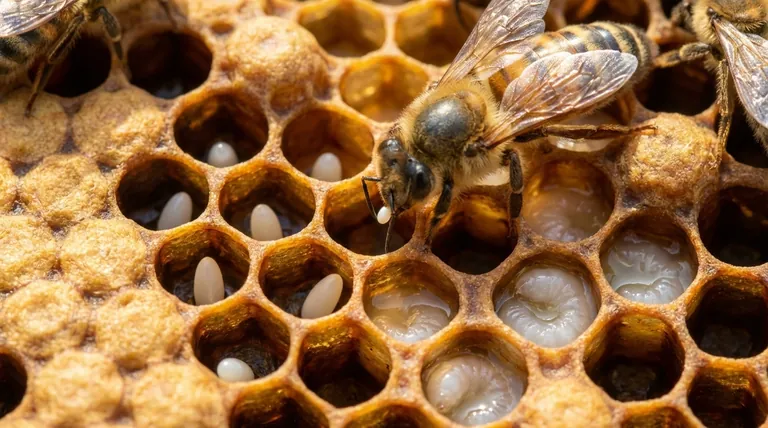In a honey bee colony, there are two fundamental types of eggs: fertilized and unfertilized. This simple biological switch is the foundation of the entire social structure of the hive, determining whether an egg will develop into a female worker or queen, or a male drone.
The core principle to understand is that the queen bee has complete control over this process. By choosing whether or not to release sperm as an egg passes down her oviduct, she dictates the sex, role, and genetic makeup of the next generation of bees.

The Fertilized Egg: Blueprint for a Female Bee
A fertilized egg contains the genetic material from both the mother (the queen) and a father (a drone she mated with). This creates a diploid individual, meaning it has two sets of chromosomes, and it will always develop into a female bee.
The Role of Diet: Worker vs. Queen
Crucially, the egg itself does not determine whether the female bee becomes a sterile worker or a new reproductive queen. This outcome is decided after hatching.
A larva fed a standard diet of bee bread (pollen and nectar) will develop into a worker bee.
However, if a larva is exclusively fed a protein-rich substance called royal jelly, it will develop into a queen.
The Unfertilized Egg: The Path to a Male Drone
When a queen lays an egg without fertilizing it with stored sperm, that egg develops into a male bee, known as a drone. This is a form of asexual reproduction known as parthenogenesis.
A Haploid Organism
Because the egg is unfertilized, a drone has only one set of chromosomes—those from his mother, the queen. He is a haploid organism with no father.
The sole purpose of a drone is to mate with a virgin queen from another colony, spreading the genetics of his mother's hive.
Understanding the Trade-offs: Colony Health and Queen Vigor
The ratio of fertilized to unfertilized eggs is a direct indicator of a colony's health and the queen's viability. A beekeeper learns to read the brood pattern like a report card.
A Strong, Mated Queen
A healthy, well-mated queen will lay fertilized eggs in a tight, contiguous pattern across the comb. This results in a solid wall of capped worker brood, indicating a strong and growing workforce.
Signs of a Failing Queen
If a queen begins to run out of the sperm she has stored from her mating flights, or if she is old or poorly mated, her ability to lay fertilized eggs diminishes.
She may start laying unfertilized drone eggs in the standard-sized cells of worker comb. An abundance of drone brood in the wrong place is a clear signal that the colony may soon need a new queen.
Reading the Hive: What the Eggs Tell You
By understanding this fundamental difference, you can assess the state and future of any colony.
- If your primary focus is colony growth: A brood frame filled with a solid pattern of worker brood (from fertilized eggs) is the best sign of a productive queen.
- If you are concerned about queen health: A spotty brood pattern with many drone cells interspersed in worker comb signals a potential problem with the queen.
Ultimately, grasping the distinction between fertilized and unfertilized eggs is the key to understanding the remarkable social dynamics and reproductive strategy of the honey bee.
Summary Table:
| Egg Type | Chromosomes | Develops Into | Key Factor |
|---|---|---|---|
| Fertilized | Diploid (2 sets) | Female (Worker or Queen) | Queen's decision to use stored sperm |
| Unfertilized | Haploid (1 set) | Male (Drone) | Queen lays egg without fertilization |
Empower Your Apiary with the Right Equipment from HONESTBEE
Understanding your colony's biology is the first step to successful beekeeping. The next is equipping your operation with durable, reliable supplies that support hive health and maximize productivity. Whether you manage a large commercial apiary or are a distributor supplying the industry, HONESTBEE provides the wholesale-focused solutions you need.
Let's build a stronger future for your bees together.
Contact our expert team today to discuss your specific needs for hive components, protective gear, and extraction equipment.
Visual Guide

Related Products
- Stainless Steel Honey Press Wax Press with Tank
- Professional Wide Blade Honey Scraper for Beekeeping and Honey Processing
- Honey Wax Separating Wax Press with Metal Screw Wax Separator Machine
- Stainless Steel Manual Honey Press with Guard for Pressing Honey and Wax
- Electric Flatting and Embossing Machine with Tray for Beekeeping
People Also Ask
- How does the press method for extracting honey work? A Simple, Low-Cost Guide for Beekeepers
- How do you press honey out of a comb? A Simple Guide to the Crush and Strain Method
- What are the key features of a honey press? Maximize Yield with Durable, Efficient Extraction
- What are the uses of honey in various industries? Unlock Its Functional Power in Food, Pharma & Cosmetics
- How was the honey press cleaned after use? Quick vs. Deep Cleaning Methods Explained



















